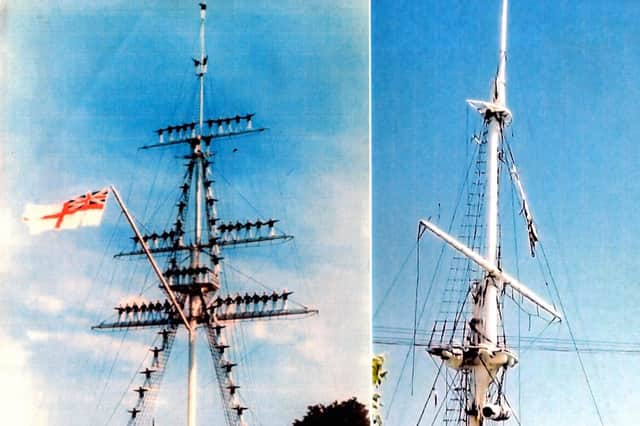NOSTALGIA: Historic HMS Ganges' mast will be saved


First of all I have to tell you that the information that was passed on to me was not quite correct.
I urged former boys and anyone else to visit the museum as soon as possible as there was a chance it would not be in existence for much longer.
Advertisement
Hide AdAdvertisement
Hide AdI visited the museum last Saturday week and Roger Jones, the chairman of the museum, told me what the position was with the museum and the old mast.
He says the museum is not closing but will have to be moved at some time in the near future, perhaps to Nelson Hall.Â
When new housebuilding takes place the hall and POs' mess is remaining, with the mess to be turned into accommodation.
The mast will be taken down but what is left of it is not allowed to be moved off the site.
Advertisement
Hide AdAdvertisement
Hide AdThe company which owns the land must have the mast put back up as new within 18 months of it being taken down.
The main mast, made of iron, is buried 18ft into the ground with about 30ft above. A wooden extension to the first platform (fighting top) was  chiselled into the iron part. The topmast, top gallant and royal, all made of wood, are all rotten and it appears they will have to be replaced.
Amazingly, the CMG, Central Messing Galley, is still in place as are all the playing fields, although they are very overgrown.
The Annex was built on many years ago and nothing can be made out of where the former mess decks were.
Advertisement
Hide AdAdvertisement
Hide AdMr Jones says: '˜We would still like to see as many ex-Ganges boys as possible make the trip back to Shotley, although we hope that we will have many more years as a museum to commemorate all of you who passed through the main gates '“ in as boys, out as men.'
'¢Enid Croft was inspired to write to me as a result of my pieces about Children's Corner at Southsea
She says: 'I moved to Portsmouth in February 1953 when I was nine and remember spending many enjoyable hours in the Children's Corner, not in the pool but at the Pets' Corner. It was situated slightly farther along towards Southsea Castle, and the miniature railway ran alongside part of it.  If I remember correctly, it was owned and run by a Mr and Mrs Hathaway, who also operated the miniature railway.
'˜When I was about 12 I used to spend all my spare time there helping with the animals. They had a few exotic animals such as a coatimundi, a rhesus monkey '“ I think, and definitely a vixen named Judy that I was sometimes allowed to walk on a lead! There were numerous other pets like rabbits, guinea pigs, ducks, goats, chickens and bantams.
Advertisement
Hide AdAdvertisement
Hide Ad'˜Sometimes I was allowed to help out at the ticket office of the miniature railway. Such wonderful childhood memories.'
Anyone else remember Pets' Corner?
'¢On July 30, I published a photograph of a Portsmouth policeman escorting three little girls across Commercial Road and asked who he was. Ian Heath tells he was George Poore.
Ian believes he retired from the Portsmouth Borough Police in 1919 and became a bank messenger. About 1923, he was assaulted in Commercial Road/Edinburgh Road and a bag containing £23,000 was stolen from him.
Poore suffered a fractured skull when he was knocked from the running board of the car belonging to the robbers which was eventually found in a lock-up garage and the robbers were caught.
Advertisement
Hide AdAdvertisement
Hide AdIn addition to their prison sentences, they received the cat o' nine tails, then a common punishment for robbery with violence.
'¢More than four years ago I wrote about a glider and towing aircraft crash at Warnford in the Meon Valley on April 14, 1944. The towing aircraft, a Stirling bomber, and a Horsa glider on a training missing hit the top of Old Winchester Hill.
The pilot of the Stirling released the glider which crashed into a field close to Warnford church. The Stirling carried on before crashing near Romsey. All 27 men in the Horsa, including 24 members of the King's Own Scottish Borderers, and the six crew from the Stirling died.
I have been contacted by John Nicholls, the son of Lt-Col '˜Nick' Nicholls who was a glider pilot and later president of the Glider Pilot Regiment Society. He says there is an idea to place a memorial and he is to ask the King's Own Scottish Borderers' Association and maybe the RAF if a joint memorial may be possible.
Advertisement
Hide AdAdvertisement
Hide AdI did visit the site of the crash with a metal detector but not much was found. If anyone had a relative killed in the crash please let me know.
Â
Â
nÂ
I wonder how many of you have visited Spitbank Fort in the Solent and wondered how they managed to build the landing stage.
Partly, it was all down to Roger Allen a former shipbreaker  who worked alongside Harry Pounds breakers yard at Tipner, Portsmouth.
I featured Roger back in March.
In 1982, Roger was approached by Sean Maguire the owner of the fort if ha could assist with placing RSJs against the forts outer walls. Roger agreed as he owned a barge with a crane. A dozen RSJs were taken out to the fort at 2.30am as the tide was just right.
Advertisement
Hide AdAdvertisement
Hide AdDivers went down and Roger lowered the RSJs one at a time. The divers used Hilti guns, semi-automatic fastening tools which could fire rivets through the a concrete RSJ and into the stone of the fort wall. The whole operation took place under water.
To assist with keeping the RSJs in place when lowered from the barge two Blue Boats belonging to the Butcher family buffered against the barge, a very tricky operation. The whole operation concluded without a hitch and in safety.Â
That is why you can now get on to the fort in complete safety.